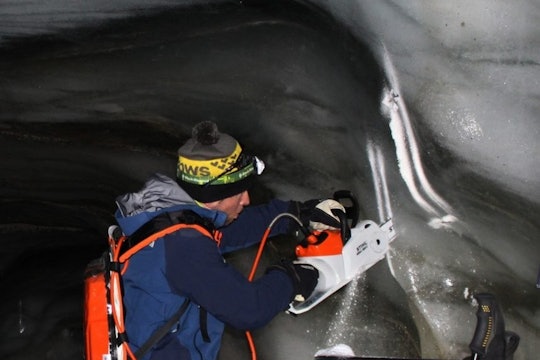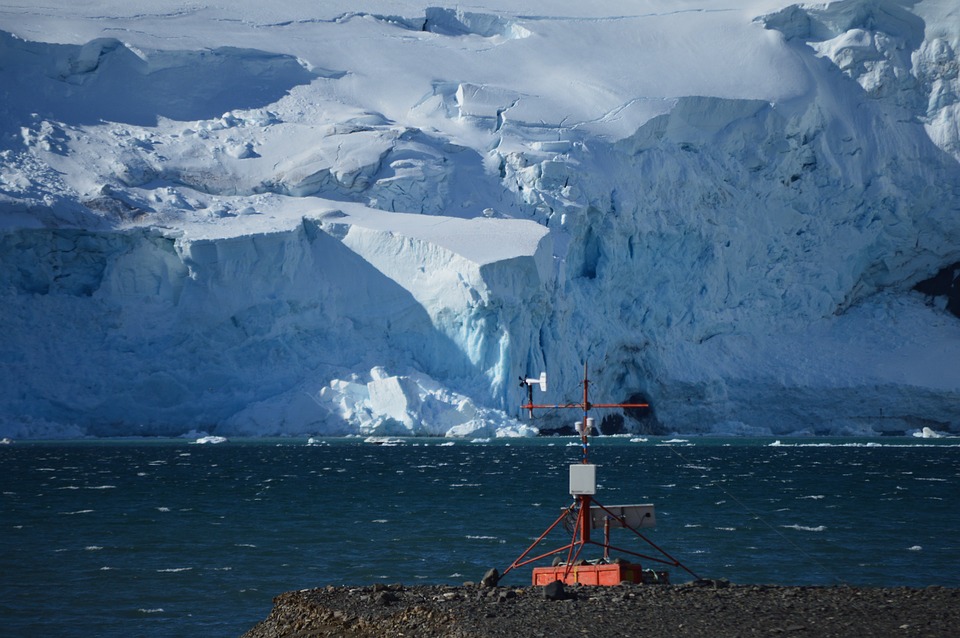
Andrea Fischer
The key to unlocking a glacier's past is a chainsaw and some quantum mechanics
The layers that are so useful in dating the glaciers are disappearing because of climate change, so scientists are finding new ways to date glaciers
High in the alps of Switzerland, quantum physicists are taking a chainsaw to the icy walls of glacier caves.
These physicists typically spend their working hours in an optics lab at Heidelberg University, where they cool and trap atoms with lasers to study quantum mechanics. Now, in collaboration with glaciologists, they think that this expertise could help them contribute to an entirely different field: climate science. By applying techniques used in atomic physics labs, researchers have forged a key to unlocking information in thousands of alpine glaciers around the world.
Glaciers have long played a big role in climatological studies. Like rings on a tree, they have well-defined layers which are determined by the annual melting, precipitation, and freezing cycle. Each layer contains little pockets of air from the time period that particular layer formed.
The further down in the glacier you dig, the older the air is; the glacier gives us a perfectly preserved time capsule of our planet’s atmospheric past. By looking at the various components of the air at a certain time period, we can learn about how the temperature and level of greenhouse gases of the planet changed over time, giving us clues about the natural climate cycles that our planet undergoes.
Studying the relationship between the increased level of pollutants in the air from the Industrial Revolution and the increased temperature of the planet can help scientists refine their models of climate change. Other glacier studies in the past have also found evidence of human-caused climate change even before the Industrial Revolution.
But with the continued warming of our planet, these glaciers – particularly ones at lower elevations – are melting. The layers that are so useful in dating the glaciers are disappearing, so we must rely on other ways to date the glaciers. Argon-39 has a half-life of 269 years, so by measuring the amount of this isotope in the section of ice of interest, we can determine how long it has been there. One problem, though: this element is extremely rare, and getting a large enough sample size to reliably date the glaciers in this way would require at least a metric ton of ice. Until now, this has precluded argon dating from being used, even with the biggest ice core samples, sections of ice about 10 centimeters in diameter with depths that can reach over 500 meters. One group in the 1970s attempting argon dating had to burrow nearly 400 meters and melt five tons of ice to capture enough argon for their analysis.

With the continued warming of our planet, glaciers – particularly ones at lower elevations – are melting, and so we can no longer rely on glacier layers for dating.
That’s where the physicists come in. Using technology developed to study quantum mechanics, researchers reduced the amount of ice they need to only one kg – a sample size easily acquired with a chainsaw and a sense of adventure. After carving out their samples in the glacier cave, the scientists pack them in a freezer and load them on a truck to be transported to Heidelberg University.
The method, known as argon trap trace analysis (ArTTA), starts in a vacuum chamber at the university. In the vacuum chamber, the air bubbles are released by melting the ice that has entombed them. The air then goes through a series of filters meant to purify the argon, and finally, a combination of magnetic fields and lasers slows down the argon-39 atoms and traps them in one part of the vacuum chamber, while letting all other atoms pass through. Since the atoms are no longer flying around at high speeds, the scientists can get a much more precise measure of the number of argon-39 atoms that were in the ice sample.
There is a limitation to this method: radioactive dating of this type typically assumes that you start with some amount of the element in the distant past. Then as that element radioactively decays over time, it becomes less and less abundant. This is true for argon-39, but there is another, competing effect that actually produces more argon-39 over time: high-energy cosmic rays can collide with argon-40 (argon-39 plus an extra neutron) and cause it to lose that extra neutron. This means that argon-39 dating may not be quite so straightforward. Researchers say that while this does cause some error in their measurement, it happens very rarely, so the effect is smaller than the current precision in their ability to date the ice samples.
For layers that are less than 100 years old, lead-210 and hydrogen-3 have both been used. If a layer is older than 1000 years, carbon-14 dating is standard, but it requires the luck of finding a tree branch, bug, or some other carbon-based item at the particular layer of interest. Argon dating is uniquely effective in determining the age of glacier layers from the intermediate time period of 100-1000 years. Its main disadvantage, the scarcity of the element, is now moot with this new technique.
While this study was a "proof of principle" with no big discoveries uncovered in the ice just yet, the technique opens up the possibility of studying thousands of glaciers across the world using the ArTTA method. And just in time, too – the continued warming of our planet is quickly melting the glaciers, erasing these records for good. Maybe the glaciers themselves will hold the key to their survival.
